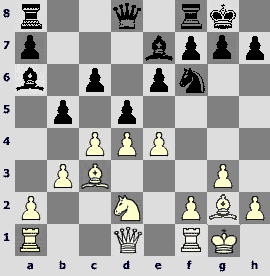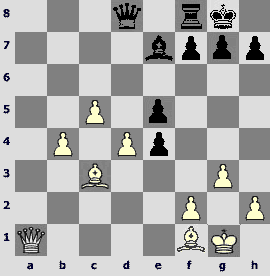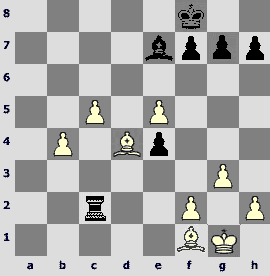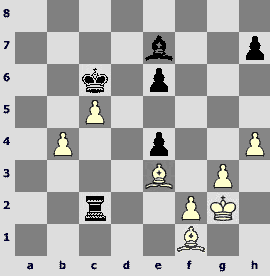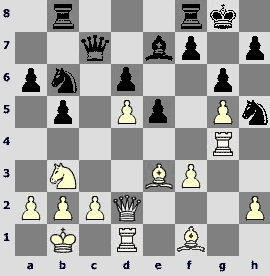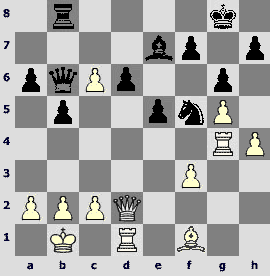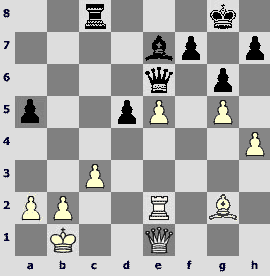29.04.2005
January’s laureates: Anand – Adams, Leko – Svidler
V.ANAND – M.ADAMS E15 Wijk aan Zee 2005 Annotations of grandmaster A.Bezgodov In this encounter Anand doubted one of the most popular variations of the Queen`s Indian Defense that he used himself successfully more than once as Black! We should say that this line was also played by Leko and Adams. No one of those who were playing this variation as White had enough courage and knowledge to try to question Black`s plan with a positional exchange sacrifice! Only Anand took the risk – and defeated a very strong opponent! 1.d4. Anand usually plays 1.е4, but perhaps he wasn`t in the mood to search for a new weapon against the Marshall Attack that was thoroughly scrutinized by the opponent. 1...¤f6 2.c4 e6 3.¤f3 b6 4.g3 Ґa6 5.b3 Ґb4+ 6.Ґd2 Ґe7 7.Ґg2 c6 8.Ґc3 d5 9.¤e5 ¤fd7 10.¤:d7 ¤:d7 11.¤d2 0–0 12.0–0 ¤f6 13.e4 b5 All this occurred more than once and even more than dozens of times. Black is trying to repel the White's pressure in the centre by delivering a flank blow. At the same time he believes in confrontation of the bishop on a6 and the rook on f1. 14.e:d5. Most probably Anand discovered this idea while preparing the variation as Black. However, he couldn`t manage to apply obtained knowledge, therefore he decided to check an exchange sacrifice as White! Such situation quite often happens to the strong players. As practice has already shown, Black can safely hold the position after a cautious 14.¦e1 d:e4 15.Јc2 ¦b8 16.¦ad1 Јc8 17.Ґf1 b:c4 18.b:c4 c5 19.¤:e4 c:d4 20.Ґ:d4 (20.¤:f6+ Ґ:f6 21.Ґ:d4 Ґ:d4 22.¦:d4 Јc5 23.¦ed1 g6 24.Јc3 ¦bc8 25.h4 h5 26.¦1d2 Ґb7іKallai – Adams, Montpellier 2001) 20...¤:e4 21.Ј:e4 Ґb7 22.Јe5 Ґf6 23.Јc5 Ґ:d4 24.Ј:c8 ¦f:c8 25.¦:d4 Ґc6 Ѕ–Ѕ Karpov – Anand,Monaco 2001. Also possible is 16...Јc7 17.¤:e4 (17.Ґf1 b:c4 18.b:c4 c5 19.d:c5 Ґb7 20.¤b3 ¤d7 21.Јb2 g6 22.Ґg2 f5 23.¤d4 ¤:c5 24.¤b5 Јb6µ Timman – Anand, Wijk aan Zee 2001) 17...b:c4 18.¤:f6+ Ґ:f6 19.b:c4 c5 20.d5 Ґ:c3 21.Ј:c3 e:d5 22.Ґ:d5 Ґb7 23.Јe5 ¦bc8 24.Ј:c7 ¦:c7 25.Ґ:b7 ¦:b7 26.¦d5І Karpov – Leko, Linares 2001) 14...c:d5. White has a prominent advantage 14...e:d5?! 15.¦e1 ¦b8 16.c5І Zuger – Zummermatter, Switzerland 1990. 15.c5! Only this move that is suggesting itself is a novelty. 15.¦e1 b:c4 16.b:c4 Ґ:c4 17.¤:c4 Јc8 18.Јa4 ¦b8 19.Ј:a7 Ј:c4 20.¦ec1 Ґb4 21.Ґf1 Ј:c3 22.¦:c3 Ґ:c3 23.¦c1 ¦a8 24.Јc7 Ґ:d4 hasn’t brought White something good, and Black has quite sufficient compensation for the sacrificed queen, Ibraev – Pedersen, Bled 2002. 15...b4. In case of other moves Anand could obtain positional advantage for free, and this couldn`t suit Adams. So he`s surely right when takes an exchange. At that moment he surely understood that had been lured into the home preparation of Anand. Such thought can`t increase the self-confidence. However, for the time being he`s defending very precisely. 16.Ґ:b4 Ґ:f1 17.Ґ:f1! A correct decision. White bishop has nothing to do on the longest diagonal under these circumstances, because there`s no chance to open it. And on the square f1 it`s going to support actively an attack of the pawns from the Queen side. Anand sacrificed an exchange exactly for this attack. 17...e5! Michael Adams isn`t a player that will agree to submit to a defeat only because of the fact that his opponent has used a new idea! He correctly decided that one can`t make indifferent and passive moves, and therefore he`s trying to 'blow up' the white pawns' chain. At any case the following idea wouldn`t be better: 17...a5 18.Ґc3 ¤e4 (18...¤d7 19.a3 ¤b8 20.b4 a:b4 21.a:b4 ¦:a1 22.Ј:a1±) 19.¤:e4 d:e4 20.Јe1 f5 21.Ґc4 Јd7 22.¦d1 Ґf6 23.d5 Ґ:c3 24.d:e6 Ґ:e1 25.e:d7+ ўh8 26.c6ќ. 18.Ґc3! The return of the bishop adds necessary harmony to the White`s position. This bishop not only strengths d4-square, but frees the way for the b3-pawn. The regaining of a pawn doesn`t offer White an advantage, e.g.: 18.d:e5 ¤d7 19.¦c1 ¦b8 20.a3 ¤:e5›. 18...a5! Perfectly played! Adams shows his best at once preventing from the move b3-b4 (although only temporarily). We should say that an attempt to create a counterplay against the white king by 18...e4 looks very appealing. White should always reckon on е4-е3, and the white king can find itself in danger. Nevertheless after the detailed analysis of the situation I`m inclined to consider it as being better for White: 19.b4 a6 20.a4 Јd7 21.b5 a:b5 22.a:b5 Јe6 23.Јe2! A necessary prophylaxis (this is what could happen if White had ignored the threatening of the opponent: 23.b6 e3 24.¤f3 e:f2+ 25.ўg2 ¤e4 26.¦c1 f5 27.Ґd2 g5 28.b7 ¦ab8 29.c6 f4 30.Јc2 g4°) 23...¦:a1 24.Ґ:a1 ¦a8 25.Ґc3! [25.¤b3 e3 26.Ґb2 e:f2+ 27.Ј:f2 ¤g4 28.Јd2 h6 29.b6 Ґg5 30.Јe2 Ґe3+ 31.ўh1 Јe4+ 32.Ґg2 Јb1+ 33.Ґf1 ¤f2+ (33...Јe4+= is enough for a draw) 34.ўg2 ¤d1 35.b7 ¦e8 36.h3 h5 37.c6 Јe4+ 38.ўh2 h4 39.Ґc1 ¤f2 40.Ґg2 h:g3+ 41.ўg1 (41.ў:g3 Јf4#) 41...¤:h3+ 42.ўf1 (42.ўh1 Јh7 43.Ґ:e3 ¤f4+°) 42...Јf5+ 43.Ґf3 g2+ 44.Ј:g2 ¤f4 45.Јg4 Јd3+ 46.Ґe2 ¤:e2 47.Ј:e2 Ј:b3 48.Ґ:e3 Јb1+ 49.ўf2 Јf5+ 50.Јf3 Јc2+ 51.ўg1 Ј:c6°] 25...¦a2 26.b6. Black has no targets to attack. His attempts to hold the most dangerous pawns "b" и "с" are self-defeating. 26...¤d7 27.b7 ¤b8 28.Јb5 Ґg5 29.Ґh3 Јc6 30.Ј:c6 ¤:c6 31.¤:e4 d:e4 32.d5 ¤b8 33.c6 Ґd8 34.Ґe5 ¤a6 35.d6 ¦c2 36.c7ќ. 19.a3 ¤e4! One more strong blow to the ambitious intentions of Anand. 19...e4 20.b4 a:b4 21.a:b4 Јd7 22.b5 Јe6 – look in the variation 18...е4; 19...e:d4 20.Ґ:d4±. 20.¤:e4. White is forced to agree to this exchange. 20...d:e4 21.b4 a:b4. This is also correct – Black should activate his pieces and open the files for it. 21...e:d4 22.Ґ:d4 Ґf6 23.Ґ:f6 Ј:f6 24.b5 e3 25.f:e3 ¦ad8 26.Јc1 ¦d5 27.c6 ¦fd8 28.Јe1 Јh6 29.¦c1±. 22.a:b4 ¦:a1 23.Ј:a1 23...Јd5. An important moment! Adams prefers to give up the second pawn, whereupon we can say with confidence that white chances are higher. Interesting is 23...e:d4 24.Ґ:d4 Ґf6 with an exchange of the strong bishop. Of course, in such case the position of the black king is weakening. But can one use it? Certainly! 25.Ґ:f6 g:f6. Black cannot exchange the queens (25...Ј:f6?? 26.Ј:f6 g:f6 27.b5ќ). 26.b5 Јd5 27.c6 f5 28.Јf6! Only like this! (28.Јa7 f4 29.c7 Јe5 30.b6 e3 31.Јa6 e:f2+ 32.ў:f2 Јe3+ 33.ўg2 Јe4+ 34.ўg1 Јe3+ 35.ўh1 Јe4+=) 28...Јc5 29.Јg5+ ўh8 30.Јe3ќ. 24.d:e5 ¦a8 25.Јc1 ¦a2. Hard and powerful! White still can`t move his pawns and is forced to set his mind to preparing the exchange of queens. 26.Јe3. The following exemplary variation shows how difficult is the aim of White: 26.Јb1 e3 27.f:e3 Ґg5 28.e4 Јe6 29.Јd3 Јb3 30.Јd7 Ґe3+ 31.ўh1 h6 32.e6 ¦f2 33.e7 ¦:f1+ 34.ўg2 ¦f2+ 35.ўh3 Јc2 36.e8Ј+ ўh7›. 26...¦c2 27.Јd4 Ј:d4. Black is forced to exchange the queens, otherwise his king can be threatened: 27...Јb3 28.Ґd2 (not 28.Ґe1 ¦c1 29.Јd7 Ґf8 30.e6 f:e6 31.Јd2 Јb1°) 28...Ґf8 (28...h6 29.Ґe3±) 29.Ґe3 ¦b2 30.Ґc4 Ј:b4 31.c6 ¦b1+ [31...¦c2 32.Ґ:f7+!! ўh8 (32...ў:f7 33.Јd5+ ўg6 34.Јe6+ ўh5 35.Јf5+ g5 36.Ј:g5#) 33.Ј:b4 Ґ:b4 34.Ґd5 g6 35.Ґ:e4 ¦c4 36.Ґd5±] 32.ўg2 Јe7 (32...h6 33.c7ќ) 33.e6 f:e6 34.Ј:e4ќ. 28.Ґ:d4. Resulting ending is difficult for Black, but he still has the drawing chances. It`s not so easy for White to move his pawns. However, it is the most arduous task to keep such an endgame. 28...ўf8 29.h4! This move calls for admiration! Anand understand that he can`t win playing only on the queen`s flank. Therefore he takes the first steps to allow White to have targets for an attack on the king`s flank as well. 29...ўe8 29...h5 30.ўg2 (30.Ґb5 ¦c1+ 31.ўg2 ¦b1 32.c6 ¦c1 33.Ґb6 Ґ:b4 34.c7 ўe7 35.Ґa6 ўd7=) 30...g6 31.Ґe3 ўe8 32.Ґb5+ ўd8 (32...ўf8 33.Ґc6 ¦c4 34.Ґd5 ¦:b4 35.c6 ўe8 36.c7 ўd7 37.Ґ:f7 ў:c7 38.Ґ:g6 ўd7 39.Ґ:h5 ўe6±) 33.Ґc6 ¦c4 34.Ґd5 ¦:b4 35.Ґ:f7 ¦b5 36.c6 ¦:e5 37.Ґb6+ ўc8 38.Ґ:g6 Ґd6 39.Ґd4 ¦a5 40.Ґe3±. 30.e6 f:e6?! Two other moves were giving more chances: 30...Ґf6 31.e:f7+ ў:f7 32.Ґe3 ўe6 33.b5 ўd5 34.b6 (34.c6 Ґd4 35.Ґ:d4 ў:d4І) 34...Ґe7 (34...¦:c5 35.b7 Ґe5 36.Ґf4ќ) 35.Ґb5 ¦:c5 36.Ґ:c5 Ґ:c5 37.b7 Ґd6±; 30...f6 31.g4 g6 32.h5 Ґd8±. 31.Ґ:g7. Obviously Black did not manage to protect his weaknesses. 31...¦c1 [31...ўd7 32.Ґd4±] 32.Ґd4 ўd7 33.Ґe3 ¦c3 34.Ґd4 ¦c1 35.ўg2 ўc6 36.Ґe3 ¦c2 It`s over now! The pawns are unstoppable. 37.Ґa6 ўc7 38.ўh3 ¦c3 39.Ґd4 ¦b3 40.b5 ¦d3 41.b6+ ўc6 42.Ґb5+ ўd5. Not anticipating for any reply, Black resigned. White pawn queens.[42...ўb7 43.c6+ќ]. Theoretically it is the most important encounter that doubts one of the strongest "defensive position" in such an effective variation as Queen`s Indian. P.LEKO (2749) – P.SVIDLER (2735) [В90] Wijk aan Zee 2005 Annotated by the grandmaster Evgeniy Najer Peter Leko mentioned this game to be the best of his encounters played in the Wijk aan Zee. Perhaps it was the clearest game of the whole tournament. It`s hard to determine the reason of Svidler`s defeat even after carrying out an analysis. 1.e2-e4 c7-c5 2.¤g1-f3 d7-d6 3.d2-d4 c5xd4 4.¤f3xd4 ¤g8-f6 5.¤b1-c3 a7-a6. The Najdorf is still often used on a high level, but it gradually loses the popularity. It`s a pity to see how fast its different braches go out of practice. Recently Black only managed to achieve some local victories, even if very spectacular (Kramnik – Topalov, Wijk aan Zee 2005). However, a repeated use of the same ideas is fraught with risks. The latest example of it is the encounter Anand – Topalov and Bacrot – Dominguez. 6.f2-f3 Along with 6.Ґe3 it is the most threatening weapon of White against the Najdorf. 6...e7-e5 7.¤d4-b3 Ґc8-e6 8.Ґc1-e3 Ґf8-e7 9.Јd1-d2 0-0 10.0-0-0 ¤b8-d7 11.g2-g4 Јd8-c7 12.ўc1-b1 b7-b5 13.g4-g5 ¤f6-h5 14.¤c3-d5 Ґe6xd5 15.e4xd5 ¤d7-b6 16.¦h1-g1! It's not yet a novelty, but it's exactly Leko who has invented an idea of this move. White doesn't refuse a thematic pawn sacrifice – ¤a5, however he strengthens his position beforehand as much as possible. In my opinion, here is another crucial game of the variation: 16.¤b3-a5 ¤b6xd5 17.Јd2xd5 Јc7xa5 18.c2-c4 ¦a8-b8 19.¦h1-g1 g7-g6 20.¦g1-g4 ¤h5-g7 21.c4xb5 a6xb5 22.Ґe3-d2 Јa5-b6 23.¦g4-b4 ¤g7-e6 24.¦b4xb5 Јb6-f2 with equal chances (Lahno – Palac , Istanbul 2003). 16...¦a8-b8 17.¦g1-g4 g7-g6 White has an advantage in the following variation 17...f7-f5 18.¦g4-b4 ¤b6-c4 19.Ґf1xc4 b5xc4 20.¤b3-a5 ¦b8xb4 21.Јd2xb4 ¦f8-b8 22.Јb4-c3 f5-f4 23.Ґe3-f2 Ґe7xg5 24.¤a5-c6 ¦b8-e8 25.Јc3xc4 Јc7-b7 26.a2-a4 , because Black fails to move on e4, in reply to 26...¤h5-f6 very strong is 27.¦d1-g1! Ґg5-h6 28.Ґf2-h4. 18.h2-h4 And finally we see a novelty. 18...¤h5-g7 It seems to be a regular and planned move, however, White is carrying out another strong idea.Robert Kempinsky tried to strengthen the play of Black with 18...¦f8-c8 19.¤b3-a5 ¤b6xd5 20.Јd2xd5 Јc7xa5 A) 21.c2-c4 ¤h5-g7 22.c4xb5 a6xb5 23.f3-f4 (23.Ґf1-c4! ¤g7-e6 24.Ґc4-b3) 23...¤g7-f5 24.Ґe3-f2 Јa5-a4! with better chances for (Papa – Kempinsky, Geneva 2005).; В) , but what can one do after 21.Ґf1-c4!; the situation is getting worse for Black after 18...f7-f5 19.¦g4-b4 ¤h5-g3 (19...¤b6-c4 20.Ґf1xc4 b5xc4 21.¤b3-a5±) 20.Ґe3xb6! (20.¤b3-a5 ¤g3xf1 21.¦d1xf1 ¤b6-c4 22.¤a5xc4 b5xc4) 20...Јc7xb6 21.Ґf1-d3 followed by the attack on the weak Black's queenside with а4 or с4. Black has no sufficient counterplay in the center. 19.Ґe3xb6! After 19.¤b3-a5 a position from the above mentioned game Lahno – Palac could occur. 19...Јc7xb6 20.¤b3-a5 White has chosen a perfect moment to seize the c6-square. With black knight still on h5 it could be met by ¤f4, and since the white rook doesn't transfer to the queen's flank, namely on b4-square, a position would be unclear. 20...¦f8-c8 Black has lost a strategic fight, and now he is forced to search for the best possible moves that could offer more practical chances. Therefore 20...f7-f5 seems to better 21.g5xf6 Ґe7xf6 (there are more chances to survive with more pieces on board). 21.¤a5-c6 ¦c8xc6 22.d5xc6 ¤g7-f5 23.¦g4-e4! An immediate goal of White is opening the files for his rooks by f4. 23...Јb6xc6 24.Ґf1-g2 ¦b8-d8 Not better is 24...¦b8-c8 25.f3-f4 Јc6-c5 26.Ґg2-h3 Ґe7-f8 27.c2-c3 25.f3-f4 Јc6-c5 Bad is 25...¤f5xh4 26.¦e4xe5 Јc6xg2 27.¦e5xe7; and as a reply to 25...Јc6-c7 could be 26.¦e4-e1 ¤f5xh4 27.Ґg2-d5 ¤h4-f5 28.¦e1-h1 with probably decisive attack. 26.Јd2-e1 The play of Leko during the whole encounter makes a strong aesthetic impression. His pieces always turn out to be on the optimal positions where they can attack and defend at once. 26.¦e4-e1?! b5-b4! 26...¦d8-c8 Svidler tries to draw his opponent away from e-file. 27.c2-c3 b5-b4! 28.¦e4xb4 Equal is 28.f4xe5 b4xc3 29.Јe1xc3 Јc5xc3 30.b2xc3 d6xe5 31.¦e4xe5 ¦c8xc3 32.¦d1-d7 Ґe7-a3 33.¦e5-e1 ¤f5-e3 34.Ґg2-d5 ¤e3xd5 35.¦d7xd5 with a won endgame as White. 28...¤f5-e3 29.¦d1-d2 a6-a5 30.¦b4-e4 ¤e3-c4 31.¦e4xc4 Leko suppresses the opponent's counterplay in the bud. 31.¦d2-e2!? ¦c8-b8 (31...a5-a4 32.f4xe5 d6xe5 33.¦e4xe5; 31...d6-d5 32.¦e4xe5) 32.f4xe5 d6xe5 33.¦e2-f2 with an idea of Вf1. 31...Јc5xc4 32.f4xe5 Јc4-e6 After 32...d6xe5 33.Јe1xe5 Ґe7-f8 34.¦d2-d4 white pieces are dominating. 33.¦d2-e2 d6-d5 33...¦c8-c7! could be more challenging. 34.Јe1-f1! A perfect move! An attack of d5-pawn seemed quite reasonable, but Leko finds another weak point in Black's position. 34...Јe6-a6 The only way to avoid the e5-е6 break. However, now White forces an exchange of queens. 34...¦c8-f8 35.Јf1-f3! ¦f8-d8 36.Ґg2-h3 Јe6-b6 37.e5-e6. 35.¦e2-d2 Јa6-c4 36.¦d2-d4 Јc4xf1+ 37.Ґg2xf1 ¦c8-d8 38.b2-b4!The performance of Leko during the whole game can be described as an aggressive prophylaxis! 38...a5xb4 39.c3xb4 Ґe7-f8 40.Ґf1-g2 ¦d8-e8 41.Ґg2xd5 ¦e8xe5 42.a2-a4 More precise is 42.Ґd5-b3. 42...ўg8-g7 Rook ending is certainly lost for Black, as position of white rook is too good - 42...Ґf8xb4 43.Ґd5xf7+ ўg8xf7 44.¦d4xb4 ўf7-e6, however, here he still had practical chances. For instance, 45.¦b4-d4 is probably a mistake becauseof 45...¦e5-e3! (bad is 45...h7-h6 46.g5xh6 ¦e5-h5 47.ўb1-c2 ¦h5xh6 48.a4-a5 followed by ¦a4, and Black can`t exchange the K-side pawns)46.ўb1-b2 ўe6-e5, and now White's win is questionable. 43.Ґd5-b3 h7-h6 44.g5xh6+ ўg7xh6 45.Ґb3xf7 g6-g5 46.h4-h5 ¦e5-e7 Desperate 46...¦e5-f5 doesn't change the situation: 47.Ґf7-g6 ¦f5-f4 48.¦d4xf4 g5xf4 49.b4-b5 f4-f3 50.ўb1-c2 f3-f2 51.Ґg6-d3 ўh6xh5 52.ўc2-c3, and with king`s support white pawns are on a way to a promotion. 47.Ґf7-g6Further events don`t need any comments. Leko does not err in such positions. 47...¦e7-a7 48.b4-b5 Ґf8-c5 49.¦d4-c4 Ґc5-f2 50.ўb1-c2 ¦a7-e7 51.ўc2-b3 ¦e7-e5 52.¦c4-e4 ¦e5-c5 53.ўb3-b4 ¦c5-c1 54.ўb4-a5 ¦c1-g1 55.b5-b6 g5-g4 56.b6-b7 ¦g1-b1 57.¦e4-e2 1-0
